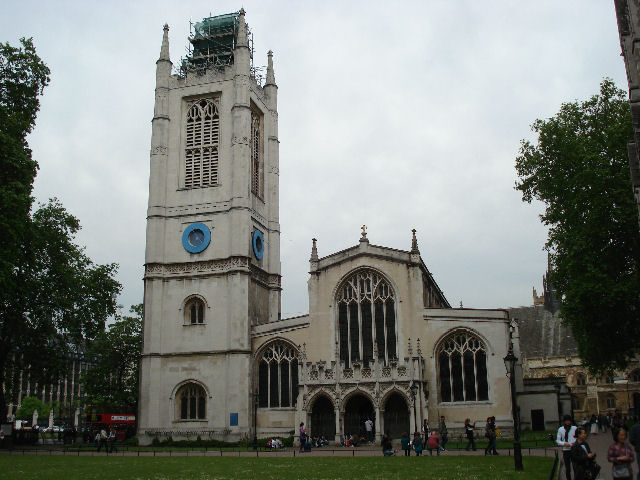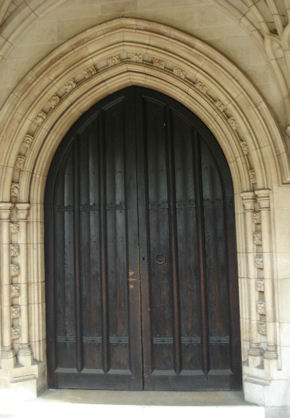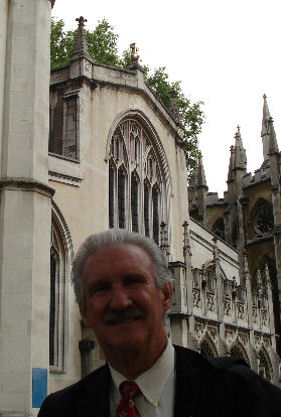St. Margaret’s Church
Westminster, London, England
Glenn Chandler, then CFA president, took advantage of a 2008 business trip to London to visit and photograph St. Margaret’s Church, a site that is important to all descendants of John Chandler of London and Virginia. The historic church is quite near many other famous London landmarks.
| Aerial photo of St. Margaret’s |

Front facade of St. Margaret’s Church, London
 St. Margaret’s Church stands between Westminster Abbey and the Houses of Parliament and is often called “the parish church of the House of Commons.” The present church, the third on the site, was consecrated in 1523, making this church the building in which John Chandler, ancestor of a number of Chandler Family Association members, was baptized. Our John is believed to have been born in 1600 and baptized at St. Margaret’s on September 7, 1600. He arrived in Jamestown on June 10, 1610.
St. Margaret’s Church stands between Westminster Abbey and the Houses of Parliament and is often called “the parish church of the House of Commons.” The present church, the third on the site, was consecrated in 1523, making this church the building in which John Chandler, ancestor of a number of Chandler Family Association members, was baptized. Our John is believed to have been born in 1600 and baptized at St. Margaret’s on September 7, 1600. He arrived in Jamestown on June 10, 1610.
According to Westminster Abbey’s web site, St. Margaret’s Church was built on the Abbey grounds by the Benedictine Monks of Westminster Abbey, whose daily routine was disturbed by the local people attending church and receiving the sacraments at the Abbey. Margaret of Antioch, to whom the church was dedicated, was extremely popular in the middle ages but little is known of her today. The original St. Margaret’s was built in the latter part of the 11th century.
The parish of St Margaret’s originally covered a large area. The baptisms, marriages, and burials registers are extensive. The original registers, which include the baptism of our John, are kept in the Abbey’s Muniment Room. Microfilms of the registers can be consulted at the Westminster Archives Centre at 10 St Ann’s Street, London.
The facade of St. Margaret’s was cased in Portland stone in 1735. The tower was largely rebuilt in the 1730s and is an important example of early eighteenth-century Gothic. Within the tower is a ring of ten bells, the oldest dating from 1739.
 Door of St. Margaret’s |
 Glenn outside St. Margaret’s |
 Westminster Abbey – This side view of Westminster Abbey, taken by Glenn from the front of St. Margaret’s, clearly demonstrates the proximity of the two churches to each other. Westminster Abbey is steeped in more than a thousand years of history. Benedictine monks first came to this site in the middle of the tenth century. The Abbey has been the coronation church for England’s kings and queens since 1066 and is the final resting place of seventeen monarchs. The present church was begun by Henry III in 1245. According to CFA member Dick Chandler, originally of Great Britain and now living in Canada, Nicholas le Chaundeler, believed to be an ancestor of the Chandler DNA Project’s Group 7B, served Henry III as a King’s Serjeant. Dick is coordinator of the Chandler One-Name Study and a co-administrator of the Chandler DNA Project.The Abbey houses many treasures, including paintings, stained glass, pavements, textiles and other artifacts. The tombs and memorials of the church comprise the most significant single collection of monumental sculpture anywhere in the United Kingdom. Westminster Abbey – This side view of Westminster Abbey, taken by Glenn from the front of St. Margaret’s, clearly demonstrates the proximity of the two churches to each other. Westminster Abbey is steeped in more than a thousand years of history. Benedictine monks first came to this site in the middle of the tenth century. The Abbey has been the coronation church for England’s kings and queens since 1066 and is the final resting place of seventeen monarchs. The present church was begun by Henry III in 1245. According to CFA member Dick Chandler, originally of Great Britain and now living in Canada, Nicholas le Chaundeler, believed to be an ancestor of the Chandler DNA Project’s Group 7B, served Henry III as a King’s Serjeant. Dick is coordinator of the Chandler One-Name Study and a co-administrator of the Chandler DNA Project.The Abbey houses many treasures, including paintings, stained glass, pavements, textiles and other artifacts. The tombs and memorials of the church comprise the most significant single collection of monumental sculpture anywhere in the United Kingdom. |
 Big Ben – From the rear of St. Margaret’s, Glenn took this photo of the Great Clock of Westminster, known worldwide as “Big Ben.” Big Ben, actually the name of the hour bell of the Great Clock of Westminster, was cast on Saturday, April 10, 1858, but its story begins more than two decades earlier. On October 16, 1834, fire destroyed the Palace of Westminster, the seat of the British government. Those few bits of the Old Palace that survived the fire were incorporated into the new buildings. In 1844, Parliament decided that the new buildings for the Houses of Parliament should incorporate a tower and clock. The bells of the Great Clock of Westminster rang across London for the first time on May 31, 1859.On the subject of church bells, Dick Chandler says, “CFA members may be interested to know that several generations of a Buckinghamshire Chandler family were renowned English bell founders in the period 1636-1726. Casting these church bells, typically weighing in excess of 2,500 pounds each, required considerable skill. At least one Chandler-manufactured bell survived for more than 350 years and rang out with its fellows across England to welcome the third Millennium.” Big Ben – From the rear of St. Margaret’s, Glenn took this photo of the Great Clock of Westminster, known worldwide as “Big Ben.” Big Ben, actually the name of the hour bell of the Great Clock of Westminster, was cast on Saturday, April 10, 1858, but its story begins more than two decades earlier. On October 16, 1834, fire destroyed the Palace of Westminster, the seat of the British government. Those few bits of the Old Palace that survived the fire were incorporated into the new buildings. In 1844, Parliament decided that the new buildings for the Houses of Parliament should incorporate a tower and clock. The bells of the Great Clock of Westminster rang across London for the first time on May 31, 1859.On the subject of church bells, Dick Chandler says, “CFA members may be interested to know that several generations of a Buckinghamshire Chandler family were renowned English bell founders in the period 1636-1726. Casting these church bells, typically weighing in excess of 2,500 pounds each, required considerable skill. At least one Chandler-manufactured bell survived for more than 350 years and rang out with its fellows across England to welcome the third Millennium.” |
- John Chandler, 1610 Immigrant and his Descendants, by Joseph Barron Chandler, published in Tidewater Virginia Families,Vol. 9, #2, 2000.
- Big Ben, //www.whitechapelbellfoundry.co.uk/bigben.htm
- St. Margaret’s Church, //www.westminster-abbey.org/st-margarets/
- Westminster Abbey, //www.westminster-abbey.org/history-research/art-architecture/
| Aerial view of Big Ben and St. Margaret’s by Joyce Chandler
|




